GIA Triple Excellent Vs AGS 000 – Are They Equivalent?
When it comes to buying diamonds, GIA and AGS are the only labs that I would personally rely on and recommend to readers. Unlike other questionable labs like EGL/IGI or private labs/appraisers, GIA and AGS represent some of the strictest and most consistent grading standards in the industry.
This means that you know what you are paying for as the 4Cs of the diamond had been accurately assessed.
Despite their authority in the world of diamond grading, GIA and AGS do have their subtle differences from each other. In a round brilliant cut, both labs use different nomenclature and methodologies in determining the cut grade of the stone.
At the top grading tiers of each lab, diamonds are rated as triple Excellent by GIA and triple ideal (000) by AGS.
| GIA Triple Ex | AGS 000 |
|---|---|
| Excellent Cut | Ideal Cut |
| Excellent Polish | Ideal Polish |
| Excellent Symmetry | Ideal Symmetry |
Some of the most common questions that I get from readers are usually in the line of: “Should I choose an AGS 000 stone over a GIA 3 Ex diamond?”, “Since AGS is grading diamonds for light performance, does it mean every diamond scoring triple zeros will look great?”, “Is a diamond with GIA Excellent ratings similar to another with AGS 0s?” and other related queries.
Well, the answers is no.
Due to the type of methodology the labs employ and the different criteria for determining cut grade, diamonds assigned with the same cut grade do not necessarily have the same level of light performance.
Here’s a fact. Not all GIA triple-excellent diamonds are created equal. Some are less brilliant than others while some are noticeably brighter. The same applies to diamonds graded by AGS although the degree of variation is somewhat lesser than GIA’s.
The table below shows the relationship between pavilion/crown angles and how the different labs utilize proportions to grade a diamond’s cut.
In the blue zones, those are “sweet spots” for AGS ideal 1s and 0s. In the red zones, it shows the proportions that are sweet spots for GIA Excellent cuts. As you can see, there are some overlapping areas whereby GIA and AGS have common ground.

Source: Accordance in Round Brilliant Diamond Cutting, Michael Cowing
If the same diamond graded by GIA as a 3EX is sent to AGS for assessment, it might not necessarily be graded as an AGS triple-0 stone. Vice versa, a 000 AGS diamond might not necessarily attain a triple excellent GIA grade.
GIA 3Ex or AGS 000 – Which is Better?
To put a long story short without going into the nitty gritty details, GIA determines the diamond’s cut grade using a combination of factors such as face-up appearance, proportions and craftsmanship elements (symmetry/polish).
On the other hand, AGS utilizes a system where individual facets of the diamond are measured in 3D instead of GIA’s 2D approach. They then subject these measurements to a ray tracing test to measure how light actually travels within the diamond. Using their proprietary ray-trace software, the light performance of the diamond is subsequently determined.
Personally, I do prefer the AGSL diamond grading report when it comes to assessing cut quality. This is because of the additional light performance data (ASET) that they provide in their top tier grading report.
Now, don’t get me wrong, I have nothing but respect for GIA. In fact, I completed my diploma and gemological studies at GIA where I also learned how they managed to implement consistent grading standards across their labs globally.
As a consumer who is shopping for an engagement ring, it is important that you rely on tangible data like videos/idealscope/ASET to make an informed decision.
The reality is, most vendors do not want to provide these data for you because it increases their costs of operations and reveals the shortcomings of their diamonds.
The AGS Lab makes diamond selection alot more transparent and simple because you don’t have to rely on the vendor to provide you with light performance images. And as a result of this, you seldom see mediocre diamonds being sent to AGS for grading.
Instead, jewelers would rather send their mediocre goods to GIA for a blanket GIA 3Ex rating because it’s much easier to achieve and puts their diamonds in a better light.
Visual Differences Between AGS 000 Diamonds
When diamonds are grading for cut quality, there is a range of proportions, appearances and performance that exist in each tier of rating. Below are 5 diamonds that were all graded by AGS to be 000 (triple ideal) and I’ve compiled the photographs of their face up views below.
Do they look totally alike to each other? Well, they don’t and you can let your eyes be the judge…
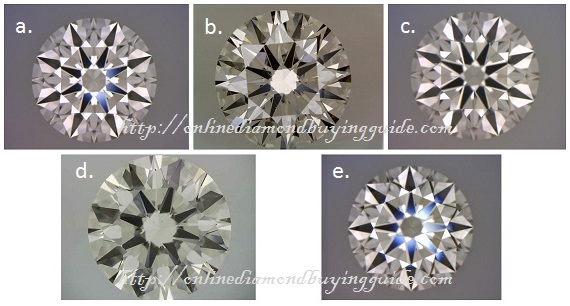
a) 1.20 Carat I Color VS1 Clarity
b) 1.33 Carat H Color SI1 Clarity
c) 0.92 Carat J Color VVS1 Clarity
d) 1.33 Carat J Color SI1 Clarity
e) 1.74 Carat G Color VVS2 Clarity
Visual Differences in GIA Ex-Ex-Ex Diamonds
Likewise, diamonds graded by GIA with the same cut grade would also display different personalities and outlooks. Check out another 5 diamonds which I’ve compiled below with their face-up photos.
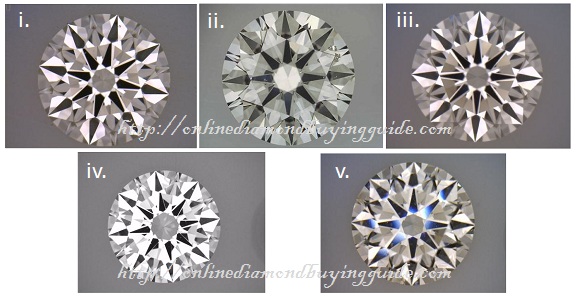
i) 1.20 Carat J Color VS2 Clarity
ii) 1.16 Carat H Color SI1 Clarity
iii) 1.01 Carat F Color VVS2 Clarity
iv) 1.00 Carat D Color VVS2 Clarity
v) 2.60 Carat J Color SI2 Clarity
Separating the Wheat from the Chaff – Evaluating Optics Using Tools
The idealscope is a handy tool for evaluating a diamond’s light performance. In essence, we want to see more red which indicates light return and less white which indicate light leakage. The black colored regions represent light obstruction and create contrast within the stone.
The images below correspond to the respective diamonds that were shown earlier.
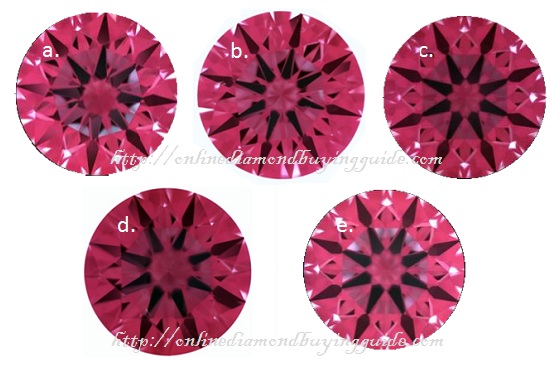
Next, here are the respective images for the GIA graded stones…
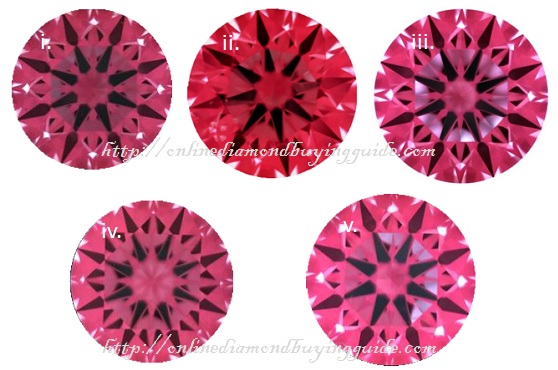
With the use of optical performance evaluation tools, we can clearly see the discrepancies between the diamonds. It’s straightforward and helps you evaluate a diamond’s performance in an objective manner.
Now, do you understand why shopping based on a certificate alone isn’t enough? A GIA grading report by itself doesn’t tell you exactly how the diamond looks like nor does it tell you exactly how well it performs.
Lab Reports Are Important But They Don’t Reveal Everything!
When it comes to critically assessing light performance in a diamond, both GIA & AGS lab reports do not offer sufficient details for consumers to make an informed purchase.
One misconception that many consumers have is that they can’t go wrong with an AGS triple-zero diamond since it is graded with light performance in mind. Well, the truth is far from that.
Both of these AGS diamonds are triple 0s and one of them (No. 2) is actually showing a slight fish eye effect due to its shallow depth!
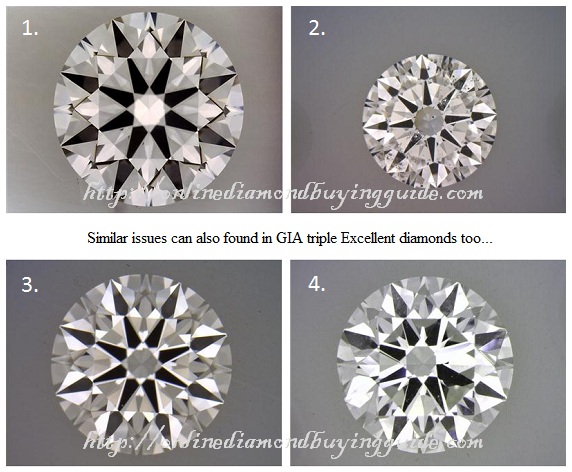
1) 1.01 carat D color VVS1 AGS ideal cut
2) 1.00 carat F color SI2 AGS ideal cut
3) 0.80 carat I color VVS2 GIA excellent cut
4) 0.70 carat I color SI1 GIA excellent cut
If you intend to buy a diamond “blind”, please think again. My point here is that you need to exercise due diligence and caution when making huge purchases.
If you are interested in a step by step guide where I will reveal the insights and concepts to choosing a beautiful diamond, make sure you read this comprehensive guide.
Related Articles
Leave A Comment

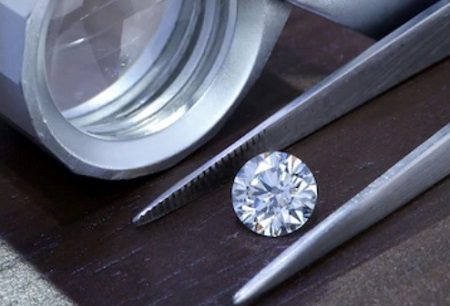


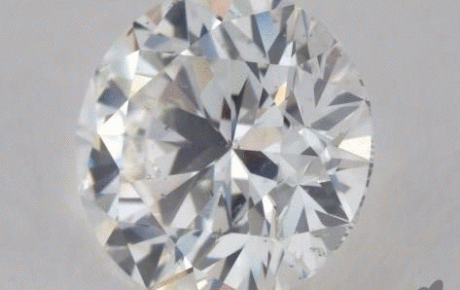









10 Comments
AGS compared to GIA seems to be a much stricter lab because of the ray tracing tests that they perform. Personally, I like the idea of quantifying brightness and light performance. In contrast, the loose GIA diamonds seem to have a much broader range of cut quality.
I agree with your views. When most people compare gia versus ags diamonds, one of the most common mistake they make is to assume that they are equivalent. They aren’t.
I want to start by saying, thank you for taking the time to help me understand and realise the difference in the cream of the crop diamonds compared to others.
I was curious as to how to evaluate two stones that are of equal greatness, what are the finer details I need to analyse or look for between them. To my untrained eye and naive knowledge, the photos all look the same to me however I’m sure there is a superior one (even if it is by a bee stick). I’ve attached the two links below. Would be keen to see if you can spot any difference or superiority.
https://www.whiteflash.com/loose-diamonds/round-cut-loose-diamond-3802914.htm
http://black.briangavindiamonds.com/diamond-details/bkags-104093020001
Lastly is there a difference between these two retailers?
Both these diamonds are top notch and on par with each other. They are the best of the best and I am saying this being as anal as I can about cut quality. Round diamonds don’t get cut better than these.
White Flash is started by Brian Gavin. It’s easy to see why cut quality standards are pretty much top notch.
Read this review: https://beyond4cs.com/reviews/brian-gavin-diamonds/black/
The difference would lie in setting selection. Let that be the deciding factor between these 2 vendors and who to work with.
You have 2 winners here.
Thanks for responding Paul.
I told my husband I think I’ve pissed this guy off with my naivety on the subject. Please understand this is a very very large amount of money in AUD terms and we are not super rich. Unlucky for my husband, I’m just diamond jewellery crazy. We have saved up for many years for my upgrade so please excuse me if I was trying to search for a fantastic stone at a more affordable price. I have been looking at diamonds from Dubai and they are substantially cheaper than the USA however they give no pictures. Whilst 3+cts is up to USD$30k difference (which is huge) without the pictures on light performance your website has educated me that it is buying blindly. I now understand that they are probably diamonds on the borderline of triple excellence and poor performers. Hence I have no choice but to look at increasing the budget.
Thank you for helping me ” to see the light”.
Back on these two diamonds. With the normal light face up pictures, is it right to say the arrows are more prominent in the WhiteFlash diamond than Brian Gavin diamond? Or not? Does that mean one is better than the other???
Is there really nothing between the two stones? Which would you pick if it was your money?
Also, why does Brian Gavin AGS reports only show the face up ASET but WFlash has both Pavillon hearts ASET image on their reports. BG told me that hearts ASET has no meaning on light performance. How is this?
Paul, you spend your time educating etc, how do you make your money or what’s in it for you in helping diamond hunters?
Beyond4cs.com was created to help readers like yourself.
Both would look identical to the naked eye in a side by side comparison. The reasons why the arrows look “clearer” has to do with lighting conditions that the vendors use to capture the images. In more fluorescent lighting, the arrows will be clear and in a spotlighting condition, it translates into sparkle.
I will reemphasize that both diamonds are on par. The inclusion of the hearts image in the grading report means NOTHING. You already have the tangible image of the hearts and arrows image that was captured and this gives more details. It’s more of a marketing thingy with AGS.
The Brian Gavin diamond is the one I would personally buy: http://black.briangavindiamonds.com/diamond-details/bkags-104093020001 just because of the story that comes behind the Black diamonds. They are a “limited” edition kind of diamond.
I have been researching diamonds for the first time ever during the past few weeks. I had zero prior knowledge of anything diamond related besides the name of the 4Cs. The name of your website and the level of detail provided is exceptional! As an engineer, I truly appreciate your efforts to publicly share in depth knowledge and technical aspects of diamonds … It makes me want take on a new career just like you! I know this email is a lot to read, but I wanted to give you some background and my level of understanding at this time so you can properly advise me.
I have a deadline of getting a finished ring by Dec 1st. I am set on a Verragio setting that I will customize and order locally. I am looking for a 2.0ct center stone with an initial budget of $20k for the diamond only. As I read more into your articles and learn more about H&A, ideal proportions, HCA, scopes, etc. I am able to perform better selections (at least I think so). However, I am starting to realize that the level of perfection I am aiming for, a $25-30k budget (diamond only) seems more like the market price.
I looked into White Flash and discovered their “A Cut Above” brand which seems to be the best of the best AGS diamonds. I understand GIA can be very loose on triple X ratings and therefore do not even make the initial selection process for this brand. Optical symmetry seem to be superior on all diamonds in this line, but will I have to worry about their light performance? I noticed a very significant jump in price from 1.9 to 2.0x sized diamonds ($15k additional) for only a bump in color and 0.2mm diameter increase. Being that I am looking at 2.0ct size, I wanted to keep the color/clarity at F/SI1 minimum. Please let me know if I am not being realistic with those levels and should be more open to lower grade options in the same “A Cut Above” brand. Either way, I want the best H&A with the best light performance possible. I’m sure you heard this a million times before.
I studied your ideal proportions for round brilliant cut and found justifying evidence in it when sorting diamonds with the HCA tool online. White Flash “A Cut Above” specifications are slightly different than what you personally select from. I know you said a variation of 0.2 degrees can throw everything off. Can you please take a look at the difference in their specs and shed some light on it for me? Should I still be selecting from that brand but still use your dimension range as an additional filtering tool?
Here are (2) 1.9ct White Flash diamonds I was looking at. I also threw in (2) 2.0+ct, one was about the same price and one was in the $20k range
1.912 ct F VS2 A CUT ABOVE 0.8 HCA
1.921 ct E VS2 A CUT ABOVE 1.6 HCA
2.053 ct G VS2 A CUT ABOVE 1.1 HCA
2.052 ct I VS1 A CUT ABOVE 1.1 HCA
I personally feel that the 1.912ct is better but compared to other diamonds small and larger, the price seems too good to be true. What are your thoughts between these diamonds? Since you now have an idea what I am targeting, do you have any loose diamond recommendations for me?
Thank you very much in advance for your time.
A variation of 0.2 degrees can throw things off. If you do a comparison, me and White Flash are pretty much in agreement on proportions. However, proportions are only one part of selecting diamonds. The point is to get tangible data to support light performance claims. And this is something that White Flash does really well and why I recommend them.
They are highly transparent and have top notch quality goods.
I can tell you that all 4 diamonds you picked have fantastic cut quality and performance. They are as good as round brilliants can be possibly cut to.
The main issue affecting pricepoints is carat size. With 2 carats, you pay a premium even though a 1.9 carat diamond will face up very much identical to a 2 carat. That’s how the industry work. It’s the same when you compare a 0.9 carat to a 1 carat diamond. Prices differ a lot assuming all else being equal.
Cutwise, these diamonds are all on par. At such a large carat size, I would stick with G or better color in order for it to face up white.
Personally, these 2 would be the diamonds I would personally buy.
https://www.whiteflash.com/loose-diamonds/round-cut-loose-diamond-3802920.htm
https://www.whiteflash.com/loose-diamonds/round-cut-loose-diamond-3859317.htm
I have a strong preference for the first diamond because it offers the best value for money. If you need to hit the 2 carat mark, the 2nd diamond would be the best option.
Either way, both stones above are stellar winners.
Hi Paul,
I hope all is going well! Thank you so much for your help with picking a diamond from enchanted diamonds. I had them inspected by a GIA/AGS appraiser and she confirmed the report from GIA and how Blue Nile categorized the quality of the diamonds.
I have a question though, I just brought the diamonds to the jeweler that I was going to have set the stones, and he said the center stone doesn’t look like an E color. I do attribute his critique to the fact that I didn’t buy stones from him, but was just wondering if you’ve heard of online retailers (like blue nile, enchanted diamonds, james allen, etc) marking up the quality of a diamond and getting GIA to sign off on that mark up? His claim is that there is a deal between online retailers and GIA that they can say a diamond is better than it actually is.
I believe that this is a brick and mortar owner trying to steer customers away from buying online. But I was quite offended when he said that the stone I bought was a H-I color. Especially considering that I took the stones to a local appraiser who confirmed the GIA report in her inspection. I did take back my stones from him and have decided to get them set somewhere else, but I wanted to get your take on this experience.
Thank you!
GIA is impartial when it comes to assigning grading. So, challenge your jeweler. Ask him to show you an E diamond and see where it is graded. If it is a GIA graded diamond, then challenge him WHY he thinks his GIA graded is an E when the diamond you brought in isn’t.
If he tries to sell you an uncertified diamond or one with a dubious inhouse report, you better run from this scumbag of a dealer.
https://beyond4cs.com/engagement-ring/beware-of-cheap-diamond-deals/
Rest assured that if GIA says it is an E, it is an E. There’s a reason why GIA and AGS are both the most authoritative labs in the world. They protect consumers.